This is a summary of what I learnt from September to December 2018, when I lost 15kg (30 pounds) of mostly fat. It has been noticeable enough to my appearance that many people asked me about my diet, whether it was healthy, and how to implement it. I learnt most things through many videos, forums, papers and books, and I could not easily direct my friends to a single article that had all the knowledge I had gathered, so I decided to write it myself. I am not a doctor, some things I write here might be wrong or misunderstood, or overly summarized. This is not a diet recommendation for anyone. This is just what I did.
About me:
I am 36, entrepreneur in tech. I used to do a lot of sports, but after I broke my knee I did less and less exercise. As an entrepreneur I dedicated more and more time to the computer, conferences, dinners, airport snacks, and I gained 14kg, to a point where I felt embarrassed to give public talks. Last year I got married and this year we decided we wanted to have children. I learnt that your spermatozoids do not only pass genetic material but also epigenetic. This meant that if I was fat I was more likely to have children who would also be more prone to gain weight. Also, being fat is bad for testosterone and fertility. I felt this was the right wakeup call to not fail at my next diet.
Past diets:
I have tried other diets in the past. The first “diet”, several years ago, was to move from Coke to Coke Zero. This easily reduced my caloric intake by about 1500 calories per week, but that’s hardly a lifestyle change. Other diets I tried included not eating chocolates or snacks, trying to generally “eat healthy”, and maybe have cheat meals on weekends. I might lose 2?3kg, then relax, then regain them.
My main problem with diets was the protocol. It’s too difficult to follow most protocols. When I read about eating 5 small meals, I would end up eating 5 average meals, and still feel hungry after each of them. I never felt satisfied and eventually gave up. Other protocols are just impossible to follow for people who travel, where they assume you can always measure all ingredients and cook your own meals.
Learning about insulin first:
Before we can speak about diets, let’s learn something about our bodies first. For my dietary plan, I think I spent more time learning about mitochondria than food. Let’s begin:
Your cells use energy to sustain themselves and for all your activities. They do this by burning food (glucose (sugars, starches), aminoacids (protein) or fatty acids (fats)) inside your mitochondria. Your mitochondria are energy plants inside your cells. You can have more than 1 mitochondria per cell. Some energy plants are bigger than others. Some are more efficient than others. You want to have many large well-functioning mitochondria to give energy to your body efficiently when it needs it (We’ll get there).
Your body usually prefers to break down glucose. It is easier. It will only break down fatty acids in the absence of glucose. Glucose gives you 4 calories per gram. Fats give you 9 calories per gram. If you have 11 kilograms of body fat, it basically means that you have 100,000 calories stored in your body, available to be burned. You probably burn between 1800 and 2500 calories per day. So basically you have stored energy for 50 days without eating anything. So why are we hungry?
Hormones. Amongst them, insulin. Insulin is released by the pancreas when we eat carbs to reduce the amount of sugar in blood. Insulin opens cells membranes to accept sugars that will either be burned for energy in mitochondria or converted into fat and stored in fat cells. While there is insulin in our bodies, our bodies simply won’t burn fats. Insulin levels takes about 2?4 hours to go down after eating carbs. So basically, if we eat every few hours, our insulin levels are always high. And we simply cannot lose any fat. No gram of fat. Nothing. So those diets of eat 5?6 times a day, small meals, are the worst. Those “detox juices” mid-day made of fruits (fructose) are just skyrocketing your insulin. If you are eating at just any time of the day, you only have low levels of insulin at night while you sleep, and the only time when you might lose any fat at all.
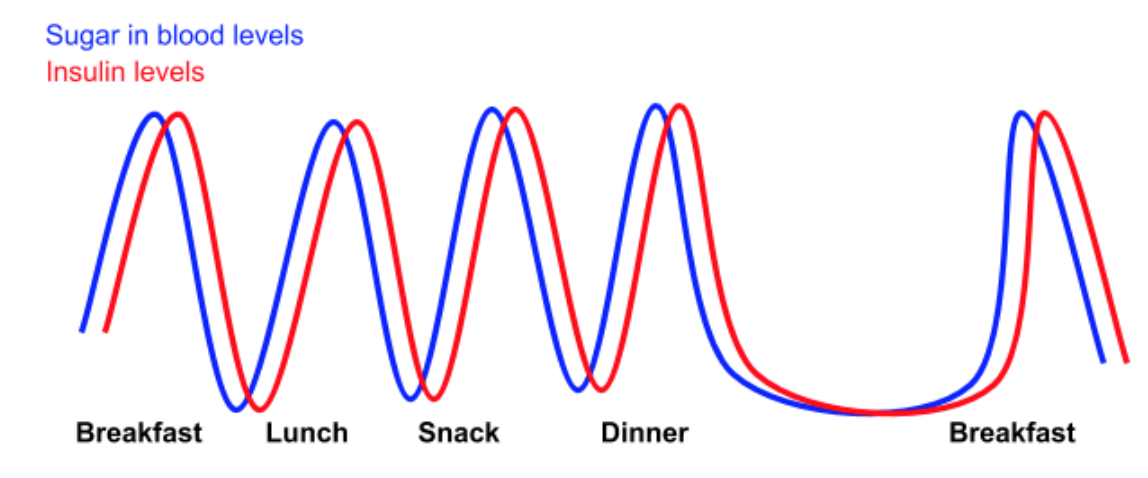
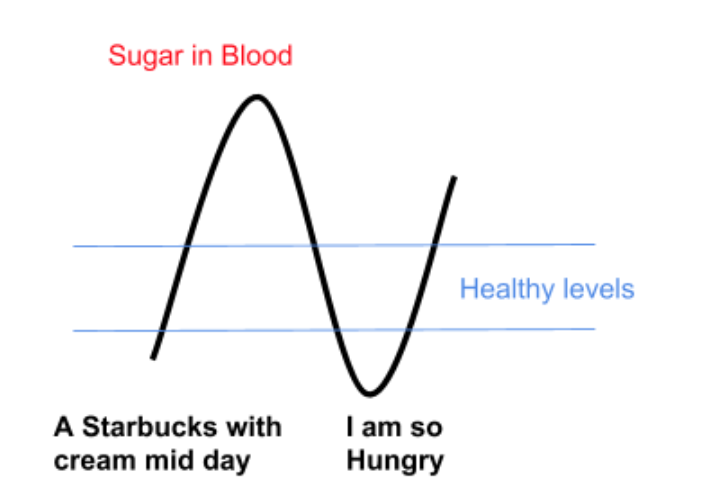
It gets worse. When we eat sugars, we release such insulin to reduce the amount of sugar in blood. Because the amount of sugars in many of our foods is monstrous, the pancreas releases a lot of insulin very quickly. This reduces the sugar amount in blood below healthy levels, and so we start to break muscle to create sugars to stabilize. You also have low energy, feel hungry and ?need a shot of sugar?, in a hormonal rollercoaster. Eating sugar makes you want to eat more sugar.
Storing and Burning energy:
We store energy in the form of fat cells (if you have 10kg of fat, you are storing 90,000 calories there, if you have 20kg of fat, you are storing 180,000 calories). This is the freezer room, and it has a large capacity. Your fat cells can always grow bigger to store more energy in case you need it in the future.
However, when we burn energy, we don’t go to the freezer. We go first to the fridge and see what’s inside. Only when it’s empty, we might check what’s inside the freezer. Our fridge is called Glycogen. We store about 250 grams of it in our liver and about 150 grams of it in our muscles. Glycogen is just big molecules of sugar combined. So those 400 grams of glycogen sugar would give us about 1600 calories worth of energy. When the fridge is empty and we eat, we fill it up. When it’s full, that’s when we store the incoming food as fat. When you do exercise, you start to burn glycogen. When you do heavy exercise and all of a sudden you feel tired, your muscles have simply run out of glycogen and needed to break other less readily available energy. 1600 calories is the basal metabolic rate of a normal person (what your body needs to function if you sleep a whole day). So in summary: If you don’t eat anything for a full day, you will not have burnt even a molecule of fat. You will have just gone through your glycogen, your energy fridge.
Because glycogen molecules are large and they need to travel to the cells that demand energy, they are surrounded by molecules of water. Every 1 gram of glycogen is going to be surrounded by about 3 grams of water. So basically we have 400 grams of Glycogen and 1200 grams of Water: Total about 2 kg?You know that feeling of starting a random lemon diet, and then you lose 2 kg, and you think “this diet is great”, and then it gets harder to lose any weight, and you end up giving up on it, and you gain the 2 kg back? That was just glycogen. You did not lose a single gram of fat there. You only emptied the fridge, and filled it back. Almost any diet you start will get rid of glycogen easily, and it will have mostly been water. So going forwards, when you start a diet, remember the first 2kg almost don’t count. You have depleted the glycogen. The real work starts at that point.
When we spend more than 4 hours without eating (most often at night), insulin levels go down, blood sugar stabilizes, and we release another hormone, Glucagon. Glucagon is the opposite of insulin. Where insulin stores sugars into cells as fats, glucagon takes fat from cells to be used as energy. Glucagon is your friend. After you deplete the glycogen, your job for a serious diet is to be “on glucagon”. Now we have the start of a “real science” that we can turn into a diet, before discussing any foods. We want to optimize for glucagon state.
The only way to stop the insulin rollercoaster and go glucagon, is to:
- Stop eating several times a day (Leads to Fasting)
- Reduce significantly the amount of carbs (Leads to Ketogenic diets).
I did both at the same time.
About Fasting:
Fasting is basically not eating for a certain amount of time. There are many protocols.
- Some people eat for 8 hours and not eat for 16 hours (it’s quite easy if you just skip breakfast)
- Eat for 4 hours and not eat for 20 hours (warrior protocol). That’s basically having a lunch or dinner, some more food after 4 hours and nothing after.
- OMAD: One meal a day. That’s what I did. It simplifies the protocol. Just one meal, then eat tomorrow at the same time.
- 5:2. Eat normally for 5 days and not eat anything (maybe up to 500 cals) for 2 days.
- >48h fasting: Just no eating for several days. You probably want to do it with some control with a doctor or at a fasting camp.
When I told my friends I was fasting OMAD, their first reaction was that this could not be healthy, and that “breakfast is the most important meal of the day”, and that I would go into starvation, and I don’t know how many other things that their mothers must have told them, because no-one gave me a single piece of scientific research to support those arguments. We have been educated to eat many times a day, but history tells us that most humans simply have not had the resources to eat more than once a day, and breakfast was only common after the 18th century. Of course there is the argument that “people died at a younger age in the past”, which is true, but they died of disease we can cure today, not diabetes.
Instead, the benefits of fasting are:
- Keep insulin at a minimum throughout most of the day. This not only enables glucagon to succeed in burning fat: It reduces your risk of developing Diabetes Type II, and it can even reverse it. Diabetes Type II is a real XXI century epidemic, and a big percentage of people who have it are not even diagnosed.
- Autophagy (eat yourself): This sounds quite bad, and maybe this is what people think “starvation” is. But autophagy looks more like Recycling. When you don’t eat for about 16?20 hours, your body thinks that there is no food coming in, and so it starts to destroy old or damaged organelles to recycle those molecules into newer parts. This is like running out of space in your phone: That’s when you remove repeat pictures, off focus, etc. While there was space, there was no point in even removing them. When there is no space you remove bad stuff to make space for better pictures, so your picture gallery is now better. Autophagy can lead to better mitochondria quality, to better senses, more stable energy, better immune system, neurons, etc. As an example, let’s say we have 6000 white cells per microliter of blood. Autophagy could recycle 2000 of the older more damaged white cells. Shortly after, you will have 6000 much stronger white cells to fight for your immunity. The discovery of Autophagy has been awarded the Nobel Prize in 2016.
You should want to enjoy the benefits of fasting every so often, even if you don’t want to lose weight.
About Keto:
Keto is about reducing the amount of carb intake, in order to reduce insulin release. Instead of carbs, you eat protein and fats. In fact, mostly fats, about 70%. Fats don’t release insulin. When you start to eat only fats and protein, insulin is not released and so your glucagon hormone starts to enable fatty acids from fat cells to be released and used by mitochondria. Keto comes from ketons, which are some form of macronutrient that your cells can use which are released from the breaking of those fatty acids.
So now your mitochondria turn to fats for energy. This is not something your mitochondria are used to do, so they need to adapt. This is called Keto Adaptation, and it’s a bit of a pain. It can take 5?7 days before your mitochondria get used to the new input for energy. Those days you might feel more tired, irritable, even angry.
The benefits of being keto adapted is that, after you are, you can tap into the 100,000 calories worth of energy you have stored. So instead of a rollercoaster of feeling tired or hungry after you run out of blood sugar, you have access to infinite high quality energy supply (1 gram of fat gives you 9 calories or energy, whereas 1 gram of sugar gives you only 4 calories).
The pain of Keto Adaptation is that it is too easy to lose it. With Keto, there are no “cheat days”. If you eat carbs one day, your body turns to carbs. And you need to readapt to fats. Over time, this adaptation takes less time, but still a pain.
About eating fats:
Fats became the enemy of the public in the 60s, when an American doctor released a flawed study that suggested that fats were the main reason for heart disease. Together with a strong lobby by the cereal industry, the food pyramid was released, with wheat, corn and potatoes at the base. Corn is very cheap to grow, and a lot of canned food will be made with some form of corn. Cattle are given corn too. This is the biggest lie we have eaten in the last 50 years.
Fats don’t make you fat. Sugar makes you fat. Even if you don’t do keto, stop worrying about “0% fat”. Eat as much as fat as you want, and start to look for foods with no sugars (which is different from “no sugars added”).
About Feeling Hungry:
Leptin and ghrelin are hormones that control hunger. When you feel hungry, it’s your ghrelin telling you to eat.
- Ghrelin will usually shoot at the same times of the day, when you train it that “it is time to eat”.
- It usually lasts 20 minutes. If you don’t eat during those 20 minutes, then ghrelin goes down and you don’t feel hungry any more. Drinking sparkling water can be a way to stop your hunger those few minutes.
- You don’t ever get “more hungry”. There is a limit to how much hunger you can feel. You are not going to feel more hungry after 8 hours or after 24 hours. So if you are considering OMAD or other Intermittent Fasting protocols, don’t be scared by hunger. It’s probably the same level of hunger you feel any day one hour before dinner.
- You can train your hormones. If you decide to go OMAD, after a few days you will only feel hungry at the time of your one meal. That helps a lot 🙂
My Protocol:
I decided to go all in with Keto One Meal a Day from day one of my diet. I decided to go with OMAD because the protocol was easier to follow. I did not have to think about how many times or at what times to eat, or what to eat in each meal and what not, and I did not have to count calories. I would eat as much as I wanted one time a day. I would feel satisfied, full, until the point where I did not want to eat more. It’s difficult to eat more than 1600 calories in one go, so in the worst case I would be saving 500?700 calories per day before doing exercise. It’s also easier for people who travel, because skipping dinner while sleeping in a hotel is easier than finding a place that will have the kind of food you need for your diet.
My one meal was at 1pm every day. After I finished eating, towards 1.30pm, I would not eat anything until the following day.
I drank about 2.5 litres of water per day, to fill up the stomach when I felt some hunger. In particular, I drank Vichy Catalan sparkling water, which is a very heavy mineral water and highly satisfying.
On weekends, I would maintain Keto but I would also have dinner so that I could have a normal social life with friends, so I did about 5 days of OMAD per week.
I eliminated Coke Zero too. I turned everything to sparkling water. There is not much research in this regard, but apparently, even if Coke Zero has no sugars, the sweet taste also releases some response from the pancreas in the form of insulin, and because there is no actual sugar to grab, then the insulin remains in your body even longer than it should. I don’t know whether this is true or not, but the point is that I eliminated it.
I started some muscle building exercise to avoid losing muscle weight. I did about 7?8 minutes per day of either squats or push ups with a $20 TRX. Nothing else. No running, no elliptical, no cardio. I did everything at home.
I bought a $30 second hand Fitbit Charge 2. I wanted to measure heart rates, sleeping patterns (apparently keto and fasting help you sleep better too), log my food and my weight.
I weighted myself every morning after peeing. I even took a small scale to hotels when I did a trip longer than 4 days.
The protocol was easy to follow because it was clear. I could eat once. Then nothing. That’s it.
I never felt hungry because I trained my ghrelin to eat once a day. I must say, at 12:30, 30 minutes before my one meal, I got really hungry. So yes, you can train yourself to control your hunger.
If for any reason I had an absolute need to eat, I would turn to olives as a snack, but this was rare.
The Food:
Now is when we start to think about foods. To summarize, look at my modified keto omad pyramid:
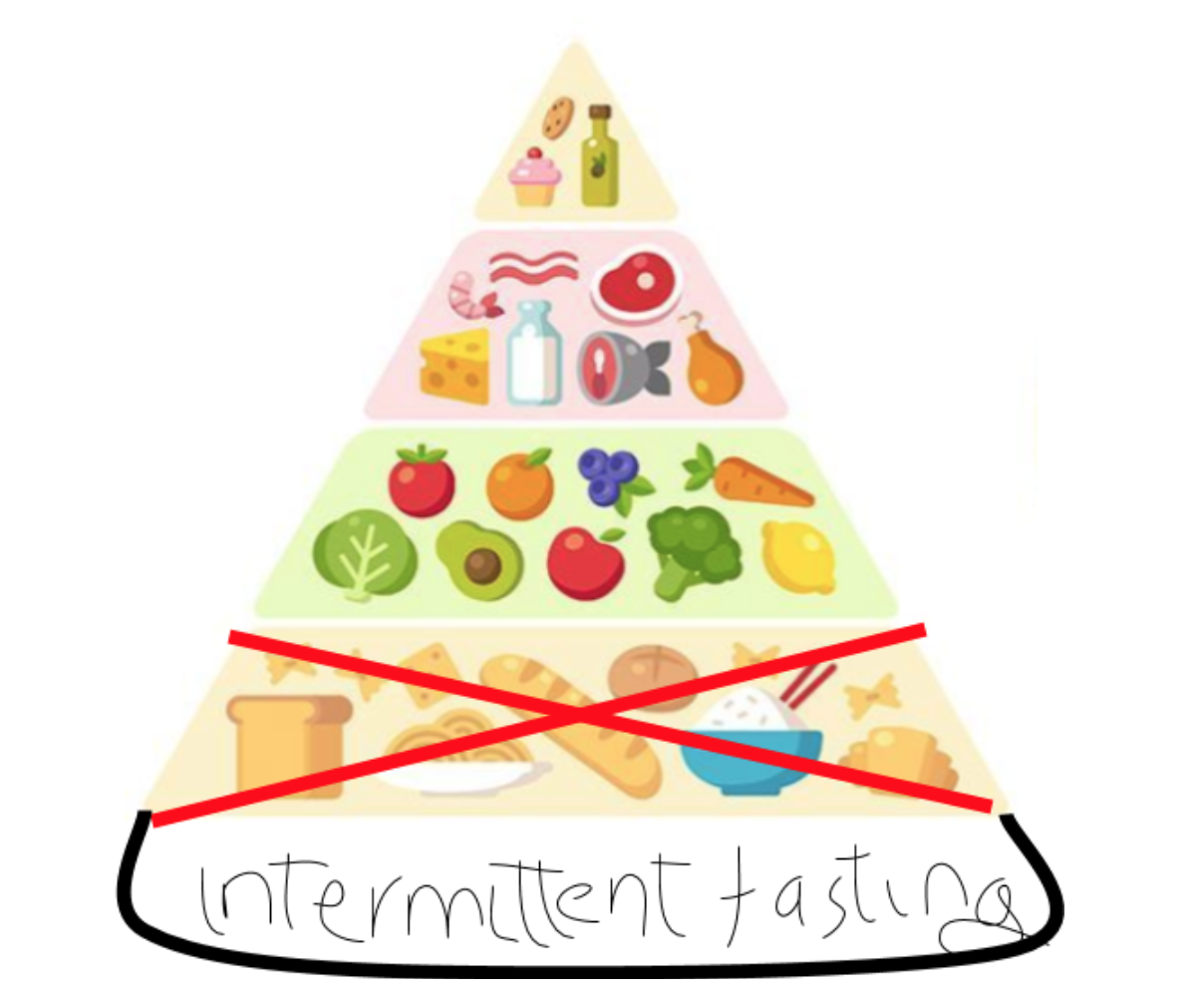 My KETO Intermittent Fasting Pyramid
My KETO Intermittent Fasting Pyramid
I completely eliminated bread, rice, pasta, potatoes, cereals, cookies, etc.
I ate a ton of salmon, tuna, olives, avocados, spinach, shellfish and cheese. A ton means that my normal meal would be 400?500 grams of Salmon, fried (that’s a lot of salmon, but I wanted to feel satisfied). 120 grams of spinach (that’s a ton of spinach too). A lot of olives (easily 150?300 grams of olives) or 1 avocado. Cheese to give flavor to my salmon salad. And olive oil, around a large spoon (a spoon is 15 grams, so that’s 140 calories in olive oil alone).
So basically, my only source of carbs was spinach. I barely ate fruits either. Bananas and pineapples have a lot of sugar. However I did eat blueberries some times (they have the lowest sugar %).
Again, I would eat so much of this stuff that I could simply not eat any more.
I did not eat dairies either. Most yogurts have very high amounts of sugars. Those with “low fat” are the worst. You should also reconsider your approach to low fat milk. If you want milk? consider the normal fat variety.
When in restaurants, I ordered fish and would remove the sauce. The good thing about fish is that you know what you are eating. With sauces you don’t. If we went to a burger restaurant, order the burger with cheese and bacon but not eat the bun or the fries. In a japanese restaurant, sashimi. In an italian restaurant, whatever chicken parmiggiano they had without pasta.
My favourite keto friendly foods are:
- Salmon and Tuna. Mostly Cooked, often raw, sometimes canned.
- Olives or Avocados. In Spain, Olives are way cheaper and easier to buy. Instead of eating meats with salads or fries, my garnish was just olives. Avocados are just as good but more expensive and they require more effort to be cut and eaten. So olives it was. Of all sizes and flavors.
- Seafood, like Octopus, easy to access too, even if the canned variety was not as healthy, sometimes this was the only protein available, or Shrimp. Super good protein
- Spinach. I just like it better than Kale or any other green. I eat them uncooked, as a salad. When I could cook, I ate a lot of peas with ham.
- Iberico Ham. The most delicious food in the world is allowed in this diet.
- Cheeses of all sorts. It’s not like the best kind of fat, but you know, when you are making this level of effort, I wanted to give myself food I enjoy.
A picture of my most common meal of the last year, where I only had to cook salmon for about 10 minutes.
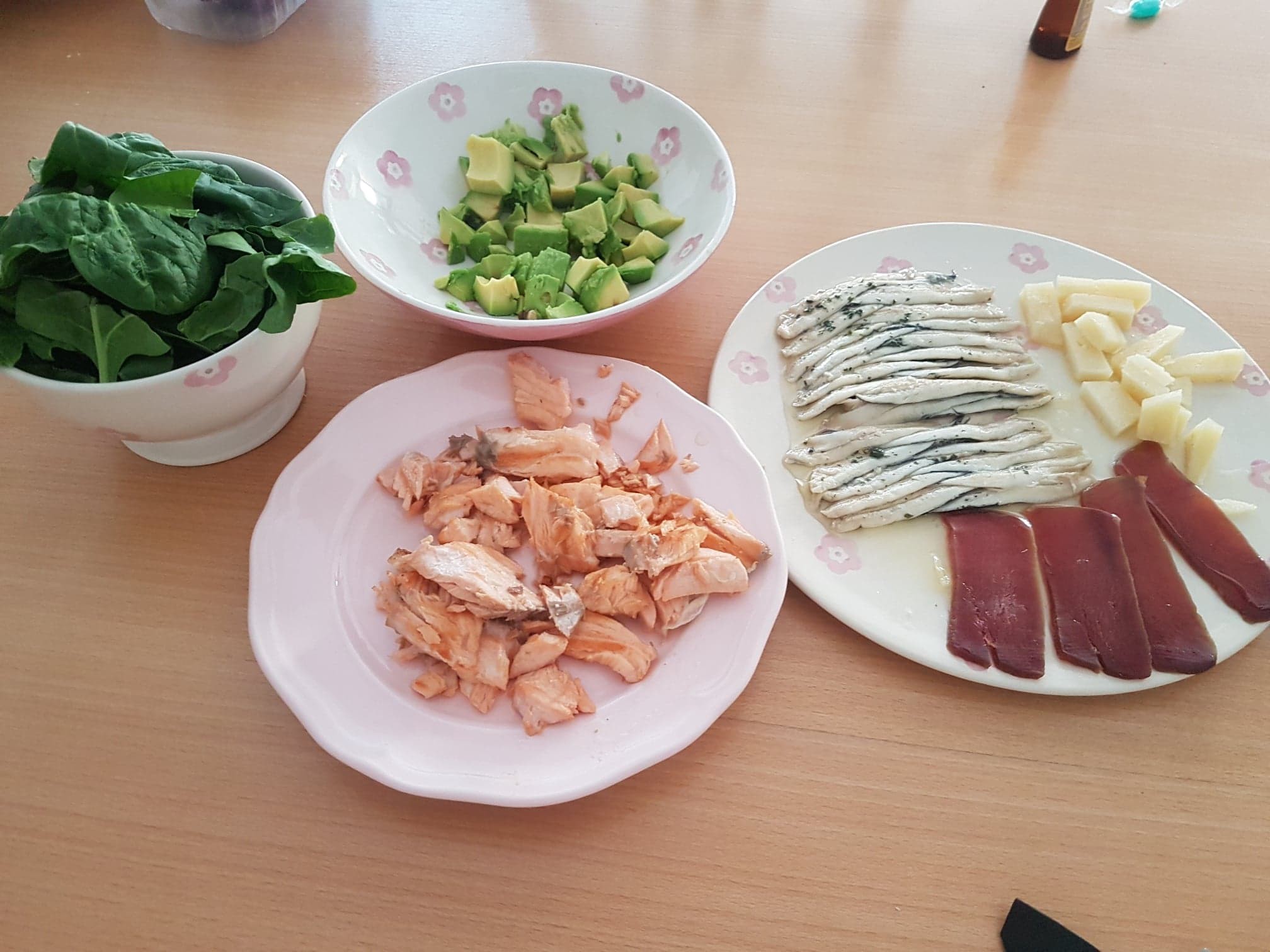 Typical Keto meal at home. About 1600 Calories
Typical Keto meal at home. About 1600 Calories
While it might sound like a very restrictive diet, many delicious foods are fatty, so I was quite happy with that.
The main misconceptions I had about food in the past had to do with starches. I have always understood that Coke or Chocolates or Pizza was “not eating healthy”. At the same time my whole life I have considered that rice was “healthy” and I felt good about my healthy effort that day. But rice is all carbs, and with a very high glucemic index which spikes insulin. The same with corn or pasta or potatoes. This misconception has dragged me for a long time. I am sure that many people consider many of their meals to be healthy when they probably are not.
My pyramid above is not perfect for Keto, by the way. Keto does not recommend fruits, or dairies, or lentils. But I think that’s an exaggeration. If you can get rid of the bottom part of the pyramid you are doing great. Eat whole foods, foods where you know exactly what you are eating, and you are 90% there. Also, put olive oil at the bottom of the pyramid instead of the top. Make it a key part of your daily diet.
Also, because I am eating only once and not eating snacks, I spent less money on food, so I could buy more “high quality more expensive foods” like red tuna.
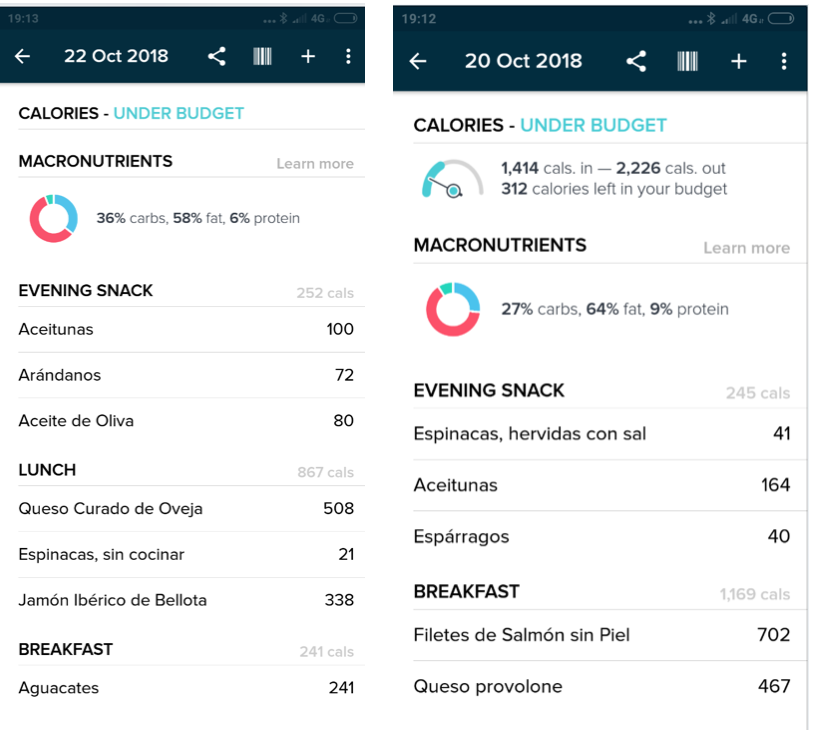
These are typical days I logged. Don’t pay attention to the “evening snack, breakfast, lunch” tags. My food was all just lunch in a single meal, I just did not log them properly. Also, I think the 27% carbs % is probably a bug in the Fitbit app and it was 27% protein, because I ate a lot of salmon/ham those day. Olives, cheese, salmon, avocados, ham, spinach and blueberries. Blueberries is the fruit with less sugar, and it has vitamin E, so it’s ok.
Results:
- Over 4 months, I lost 15Kg. Of those, 2kg were of water (glycogen), 11 kg of fat and 1.5kg of muscle (it’s almost impossible to bulk while you are in a 1000 calories per day deficit). I measured this with a professional Bioimpedance measure at the beginning and end of my 4 months.
- My body fat has gone down from +25% to less than 16%. This is before doing any serious exercise as explained.
- I have gone from the Obese region to Overweight to Normal in BMI.
- My metabolic age (this is measured by the same bioimpedance machine from my nutritionist) went down from 45 years old to 27 years old. My nutrionist was so shocked she has started to learn about Keto because she had never seen a drop of fat weight like that (I had visited her for the measurements, not for the advice).
- We got pregnant :), which I cannot associate to keto or fasting, but I am happy to have passed better epigenetics with a lower body fat.
Long Term Lifestyle:
It’s not reasonable to think that I will not eat Paellas in the future, or potatoes or bread. I love bread. But now I have a protocol I can follow with consistency.
My objective for the coming years is to do OMAD at least 2?3 days a week, and Keto whenever possible, but without affecting what other people might want to eat (family, events, etc).
I might also go into 3?4 day fasting periods once or twice a year in fasting camps to boost autophagy and renew my organelles.
Even on days I don’t do OMAD, I have completely eliminated breakfast and snacks, so at the very least I am doing 16:8 every day.
Problems and Challenges:
The problem of Keto is that you need to be many days on keto in order to adapt. This requires a level of consistency, but it’s not really that hard.
Dinners with friends. You will not be able to keep OMAD every day. Those days you might want to just skip the fasting but maintain keto, or not have your lunch.
There is very little literature about keto in long term studies. Eliminating carbs might have some long term risks that we are not aware of today.
My sister is a doctor and thinks that keto cant be healthy. She did not give me any reasons for that, other than we release acetone as part of the fat burning. She promised to do some research to find the weaknesses but I am still waiting.
Factoid 1: Burning food
When you “burn fat”, do you know where that fat goes? Most people seem to think you “poo” the weight, or the fats “turn into energy” or plasm or something. Both are wrong.
- Poo is just a % of the food that enters the tube and then leaves the tube. It also has about 5?10% of biomass from gut bacteria but that’s about it. There is no “fat that you are burning”.
- Similarly, fat molecules does not just “burn” into “energy”. We are not nuclear plants that destroy atoms. The principle of mass conservation remains in your body. The atoms need to leave.
When you burn fat it turns into H20 and CO2. Forget the H20 for a moment because there are too many things that come and go in the form of water inside and outside your body (pee, poo, sweat) and follow the CO2. When you breath in O2 and you release CO2, you are eliminating the Carbon atoms from your body, about 40 mg of CO2 per breath. A molecule of fat (triglyceride) is C55H98H6, so 55 atoms of Carbon. Do the math to know how many times you have to breath out your fat to lose weight :). Yes, the only way you lose your carbon atoms of fat is by breathing them out (the rest is pee and sweat).
Factoid 2: Sugar
1 gram of sugar is 4 calories.1 desert spoon is about 4 grams of sugar or a sugar cube.Let’s look at some labels of “healthy foods”:
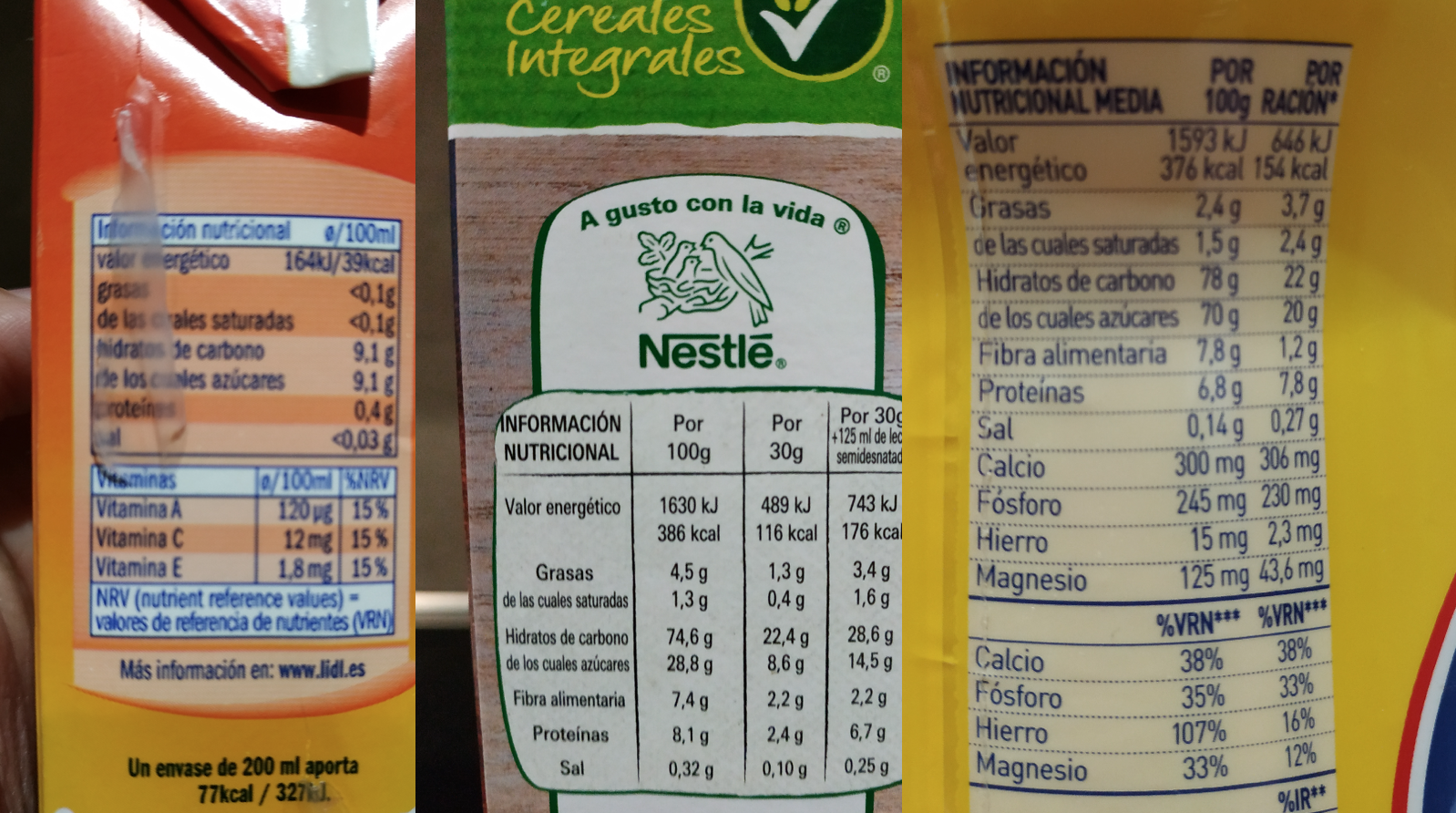 Orange Juice, Nestle Cereal, Colacao
Orange Juice, Nestle Cereal, Colacao
One day these will be forbidden. Colacao, the Spanish “breakfast for champions” that sponsors the Spanish olympic team is 70% sugar. Nestle healthy cereal are mostly sugar. The children juice advertised as “no fat” is mostly sugar. Those 9 grams of sugar per 100ml mean 18g of sugar in that tiny juice box, which, divided by 4, means about diluting 4.5 spoons of sugar to start the day. I took these pictures before tossing those foods.
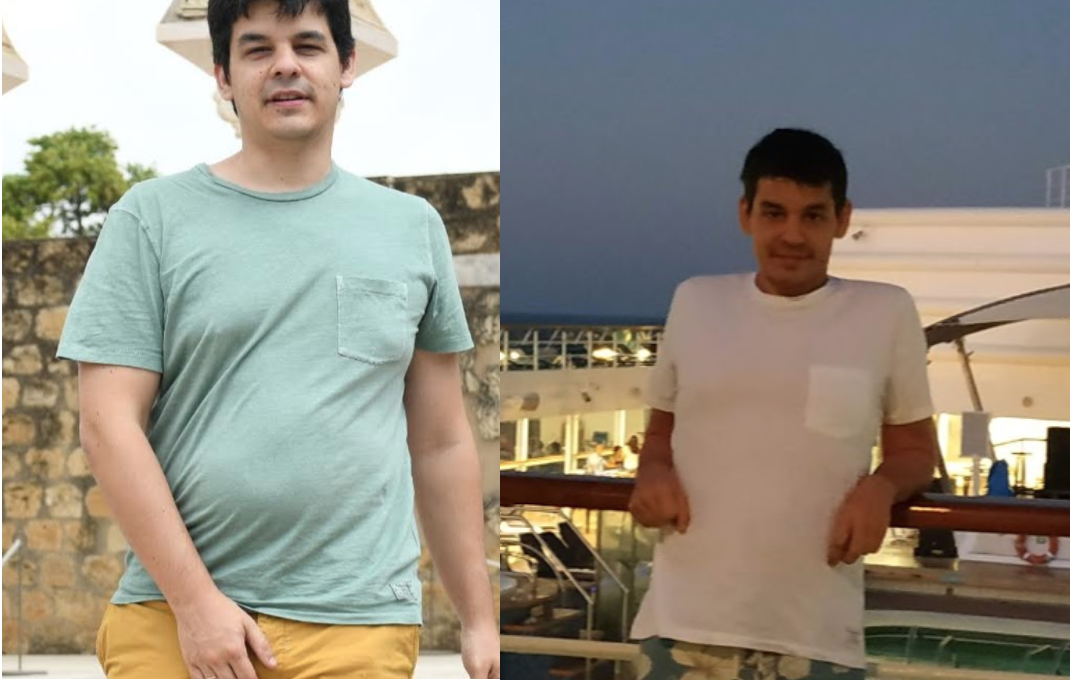
A final picture to help illustrate. Left is from summer 2018; Right is December 2018. And that?s it. I hope this is useful to someone. Happy 2019!
PD) I took my fat % measurements and learnt first about Intermittent Fasting at balneario.com Longevity School in Valencia, Spain.
PD2) I wrote a follow-up article about a 5-day Water fast that might be of your interest too


